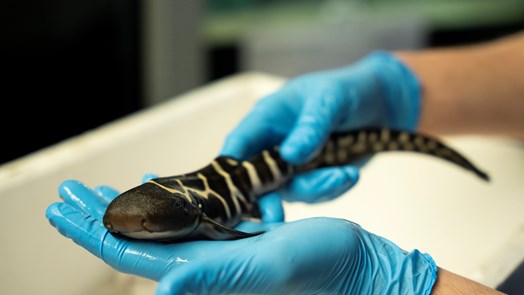Everyone has heard of a sponge before. However, not everyone would be able to tell the front of a sponge from the back, much less be aware that sponges have an important role in the Ocean. These hidden living creatures have plenty of secrets, some of which I will reveal in this article. In some countries, dried sponges are used for cleaning surfaces. In Burgers’ Ocean, living sponges are used to keep the water clean.
What is a sponge?
A sponge is a very simple animal. A sponge does not have a heart, a brain, or even any organs. Sponges are the most primitive multicellular organisms. They are unique in their simplicity—a recipe for success that makes it possible to survive in various aquatic environments. This allows them to live in the ocean at great depths, but also in bodies of freshwater in the Netherlands.
A sponge only has a few types of cells and is always fixed to its substrate. Sponges are a type of filter. Water flows into the animal through countless small holes, where special cells extract food from the water and the remaining water is released again through a few large holes. Small moving hairs (flagella) on certain cells keep the water flowing, but a little help from Mother Nature is also important. Therefore, sponges enjoy an environment with a strong current.
Sponges in Burgers’ Ocean
In the coral reef, many sponges fixed themselves to the ‘living stones’ that are the building blocks of the reef, particularly in the beginning. These ‘living stones’ are porous rocks from the sea around Indonesia that contain an abundance of tiny aquatic organisms. During the coral reef’s first year, the sponges flourished. The circumstances were perfect for these filtering animals. You could see purple, black, grey, red, and yellow colonies growing all over the rocks. Dr. Van Soest from the University of Amsterdam, one of the foremost sponge specialists in the world, was able to determine twenty different species. However, something went wrong in the sponge kingdom soon after. This was because the water in the coral reef became cleaner, which resulted in less available food. Furthermore, the sponges could not successfully fight for room against algae, coral, and other organisms that use light for energy.
The dark life
Sponges live in natural coral reefs, largely tucked away in caves, holes, or beneath the coral. This is because most sponges do not require light to survive. It is simpler for a sponge to disappear into the darkness than to fight all other kinds of lifeforms for a place in the light. This is visible in the coral reef in Arnhem as well. Most sponges that are still found in the coral reef basin are hidden beneath stones. This is also smart as different species of angelfish, which are part of a sponge’s diet, swim in the basin. There was once a sponge in the reef that grew very quickly, because it established a symbiotic relationship with algae as often is the case with many species of coral. In the world of the aquarium, this sponge became known as the ‘killer sponge’, because it became notorious for growing over the coral. We removed it from the basin before it caused any problems. Burgers’ Ocean does not have a real ocean around the corner that regularly deposits sponge or coral larvae into its waters. When species in the coral reef basin disappear, they do not return on their own and must be replaced by hand.
Breeding sponges
In the scientific world, there is great interest in breeding sponges. This is primarily because sponges produce substances that are highly significant to the biochemical industry. These special ‘sponge substances’ are toxic to certain kinds of cells, which makes them perfect for medical applications. Sponges produce these substances to prevent being consumed, which is why most other species of animals tend to leave them alone. However, it has not proven easy to breed sponges. Simulating the appropriate environment with the proper nutrients is difficult. In the Ocean, sponges currently do very well in the tunnel basin. When standing in the tunnel, you can see enormous walls and pillars of sponges that look nothing like the ones you are used to seeing in your bathtub! In this basin, the circumstances seem to be good and there is also a lack of natural predators. There are even more sponges settled onto a portion of the filter! The denitrification filter removes nitrates from the water with the aid of specialised bacteria. The sponges feed off the waste products of these bacteria as well as off the bacteria’s leftovers. This gives them an important function as part of the filter and they may even be very important for the quality of the water in the coral reef basin. The introduction of more sponges into the coral reef may become an important component of its future development.



